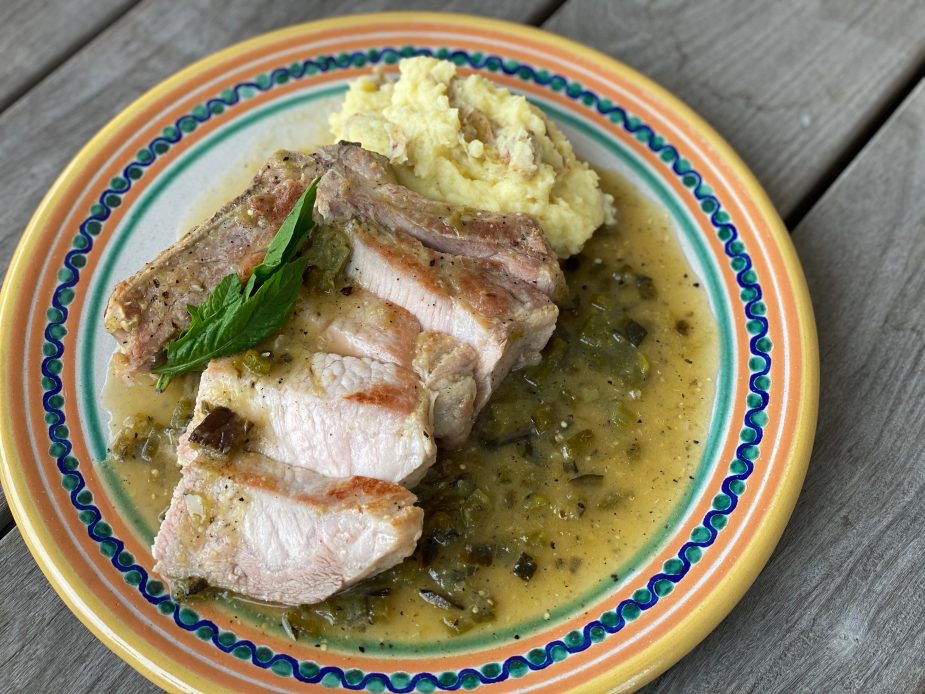
INGREDIENTS
- 4 bone-in pork chops (see note above) that are ¾ to 1 ½ inches
- Salt
- 1/4 cup sugar
- 1 pound (6 to 8 medium) tomatillos, husked and rinsed
- 1 small (4-ounce) white onion, sliced ½-inch thick
- 4 garlic cloves, unpeeled
- 2 fresh poblano chiles, cut in quarters lengthwise, seed pod and stem removed
- 2 large (5 to 6 ounces each) cleaned nopal cactus paddles
- 2 tablespoons fresh-rendered pork lard or vegetable or olive oil, plus a little more for brushing the nopales
- About 1 cup roughly chopped cilantro, plus extra for garnish OR 2 large epazote sprigs, plus extra for garnish
- 2 cups chicken or pork broth
INSTRUCTIONS
Brine the pork. Fill a 4-cup measure with very hot tap water, add ½ cup salt and the sugar, and stir to dissolve. Pour into a 13 x 9-inch nonaluminum baking dish and add 4 cups cold water, bringing the mixture close to room temperature. (If you’re cooking thin chops, you can make half this quantity.) Submerge the chops in the brine, moving them around a little to ensure that the brine gets underneath. Brine the thin chops for 30 minutes, the thick ones for 1 hour.
Roast the vegetables. Turn on the broiler and position one of the racks as high as it will go. On a rimmed baking sheet, lay out the tomatillos, onion slices, garlic and cleaned nopales. Lay on the poblanos, cut-side down, and press them to flatten as much as possible. Brush (or spray) both sides of just the nopales with oil or lard. Slide the baking sheet under the broiler and roast everything for 6 or 7 minutes, until the tomatillos are blistered, blackened and soft. Remove the baking sheet and check everything. The onion should be a little charred, the garlic soft, the poblanos’ skin blackened, and the nopales slightly charred, olive color and limp; if they’re not, give them another minute under the broiler.
Make the sauce base. Scrape the tomatillos and onion into a blender or food processor. Peel the garlic and add it, too, along with the cilantro (keep epazote to add later). Blend to a coarse puree.
Chop poblanos and nopales. When the chiles and nopales have completely cooled off, rub the blackened skin from the chiles, rinse briefly, then cut into ¼-inch pieces. Cut the nopales into ½-inch pieces.
Sear and simmer the pork. When the pork chops have been in the brine for their required time, remove them and dry thoroughly with paper towels. Heat a very large (12-inch) heavy skillet—cast iron is the best here—over medium-high until very hot. Add the lard or oil, tilting to coat the pan evenly, then lay in the pork chops. Cook until richly browned underneath, about 3 minutes, then flip and brown the other side. Remove to a rack set over a plate. Immediately add the tomatillo puree to the hot skillet. Stir for a few minutes, as the mixture reduces and thickens, then stir in the broth. Taste and season with salt, usually about a teaspoon depending on the saltiness of the broth. When the mixture comes to a bare simmer, reduce the heat to medium-low so that there is only the slightest movement on the surface of the sauce. Stir in the poblano and nopales, then nestle in the pork chops. (If using epazote, nestle it in with the pork.) Cover (if your skillet doesn’t have a lid, use a baking sheet) and let the chops coast slowly toward doneness. For the thin chops, that’ll be about 5 minutes; for the thick ones, I cook them about 5 minutes, then flip them over and cook for another 5 to 7 minutes longer. That’s how long it will take for the chops to reach medium, which is how I like my pork—about 150 degrees on a thermometer, pink at the center, still offering a little give when pressed firmly with a finger.
Serving. Remove the pork to a warm deep platter or warm deep dinner plates. Spoon the sauce over the pork and you’re ready to serve.